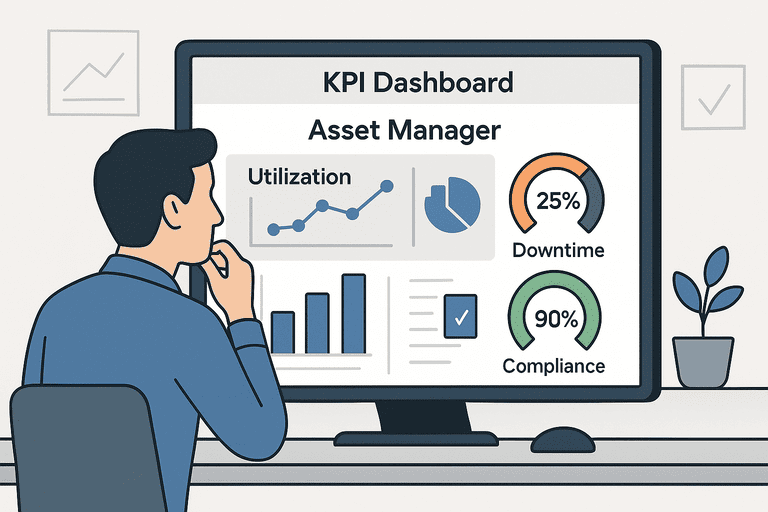KPI Dashboard for Asset Managers: Metrics That Matter
Discover the most important KPIs for asset managers — from utilization and downtime to audit accuracy — and learn how to design a dashboard that drives better decisions.

Introduction
An asset management system is only as powerful as the insights it provides.
Modern organizations generate vast amounts of data — but without a well-designed KPI dashboard, that data often remains unused.
For asset managers, the goal isn’t to collect metrics for the sake of reporting — it’s to measure what truly impacts performance, reliability, and cost efficiency.
In this article, we’ll break down the essential KPIs that matter, how to visualize them effectively, and how dashboards help teams act on insights faster.
1. Why KPIs Matter in Asset Management
KPIs (Key Performance Indicators) are the foundation of data-driven asset management.
They help answer key operational questions like:
- Are our assets being used efficiently?
- Where are we losing money or time?
- Which equipment needs replacement or repair?
- Are we compliant with audit and maintenance schedules?
Dashboards turn static reports into living insights, helping teams detect trends, forecast issues, and communicate performance to leadership.
2. The Four Pillars of Asset Management KPIs
| Pillar | Focus | Key Outcomes |
|---|---|---|
| Utilization | How effectively assets are used | Maximize ROI and productivity |
| Maintenance | Performance, downtime, repairs | Reduce unplanned failures |
| Financial | Cost efficiency, depreciation | Improve budgeting and forecasting |
| Compliance | Audits, certifications, and policies | Ensure accountability and legal readiness |
Each pillar supports a different layer of operational visibility — together, they form a complete performance picture.
3. Essential KPIs for Asset Managers
1. Asset Utilization Rate
Measures how often assets are in active use.
Formula:
(Time in use / Total available time) × 100
Helps identify underused equipment or overbooked assets.
2. Maintenance Cost per Asset
Tracks ongoing maintenance spend relative to asset value.
High costs can indicate poor maintenance planning or aging equipment.
3. Mean Time Between Failures (MTBF)
Indicates equipment reliability.
Longer intervals mean more stable operations and fewer interruptions.
4. Mean Time to Repair (MTTR)
Tracks the efficiency of repair workflows.
Low MTTR means issues are resolved quickly, minimizing downtime.
5. Audit Compliance Rate
Shows how many scheduled audits were completed on time.
Essential for ISO, financial, or internal compliance tracking.
6. Asset Value by Category
Helps visualize which categories (IT, machinery, furniture, etc.) represent the largest share of your total asset base.
7. Total Cost of Ownership (TCO)
Includes purchase price, maintenance, energy, and disposal costs.
Provides a realistic lifetime cost view per asset.
8. Asset Downtime Percentage
Quantifies how much time equipment spends out of operation — a key efficiency driver for service or production environments.
9. Depreciation Trends
Shows the declining value of assets over time, useful for accounting and replacement planning.
10. Asset Lifecycle Stage Distribution
Displays how many assets are in each phase — active, under maintenance, or decommissioned — for clear lifecycle visibility.
4. Designing an Effective KPI Dashboard
A useful dashboard is not overloaded — it’s clear, interactive, and relevant.
Best practices:
- Limit to 10–15 KPIs per view.
- Use visual hierarchy — large cards for critical metrics.
- Apply color-coded thresholds (green = OK, yellow = warning, red = action needed).
- Combine charts for trends and cards for snapshots.
- Include filters (by department, location, asset class).
- Schedule automated email summaries for leadership teams.
5. Visualization Types That Work
| Visualization | Best for | Example |
|---|---|---|
| Line chart | Trend analysis | Depreciation, maintenance costs |
| Bar chart | Comparisons | Asset categories by value |
| Pie chart | Distribution | Lifecycle or location breakdown |
| Gauge | Performance metrics | Utilization or compliance rates |
| Heatmap | Multi-site monitoring | Asset usage by department or region |
The dashboard should tell a story, not just display numbers.
6. Data Sources and Integration
Modern dashboards aggregate data from:
- Inventory systems (asset details and usage logs)
- Maintenance tools (work orders, repairs)
- Finance systems (costs, depreciation, budgets)
- IoT sensors (real-time condition data)
- Audit and compliance modules
An API-driven approach ensures your KPIs stay live and accurate, without manual updates.
7. Benchmarking and Continuous Improvement
To maximize value, compare KPI trends across:
- Time periods (month over month)
- Departments or locations
- Industry averages
Benchmarking identifies outliers and improvement opportunities — the foundation for a continuous optimization loop.
8. Common Pitfalls to Avoid
🚫 Tracking too many metrics (“dashboard fatigue”).
🚫 Failing to define KPI ownership.
🚫 Ignoring data refresh frequency.
🚫 Presenting lagging indicators only.
🚫 No actionable insights or alerts.
Dashboards should inform action, not just observation.
Conclusion
A well-built KPI dashboard empowers asset managers to move from reactive reporting to strategic foresight.
By tracking the right metrics — utilization, maintenance, financials, and compliance — you build a culture of visibility, efficiency, and accountability.
The best dashboards don’t just measure — they drive smarter decisions every day.
Explore related topics: